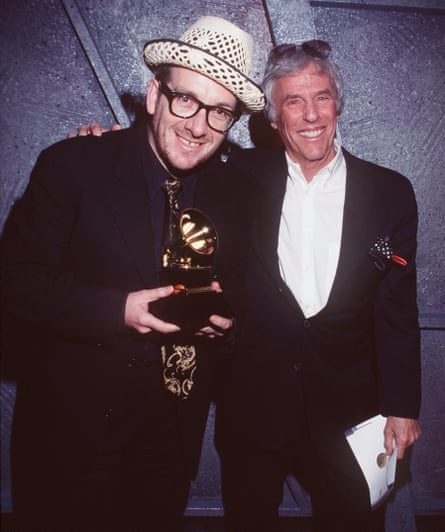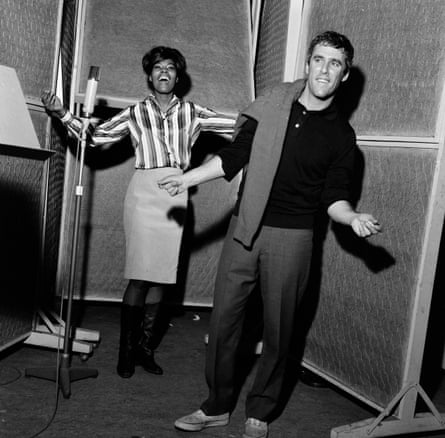With the arrival of rock’n’roll, pop music divided, broadly speaking, into two categories. There was music aimed squarely at the recently discovered teenager that frequently seemed to have the specific intention of alienating their forebears. And then there was the music that carried on much as it had in the years between the end of the second world war and the appearance of Bill Haley, Elvis Presley, Little Richard et al. Look at the charts from 1952 or 1953, and they’re packed with songs that seem to target an older demographic, who didn’t want shock or rebellion or white-hot excitement, but something to soothe or buoy them along, what eventually became known as easy listening.
The twain very seldom met: if anything, the divide became more pronounced as the 1960s wore on and a cocktail of new technology and new drugs meant the music aimed at teenagers became more adventurous, strange and innovative. Look at the charts from 1966 or 1967 and you’ll find a stark split: Strawberry Fields Forever and Purple Haze versus Engelbert Humperdinck and Ken Dodd’s Tears.
But Burt Bacharach’s music existed somewhere in the middle. He often got lumbered with the term easy listening. You could see why – his own albums, such as 1965’s Hitmaker! or 1967’s Reach Out, tended towards syrupy arrangements and cooing vocal choruses. Usually compilations of songs other performers had already made successful, they seldom showed off his compositions to their best effect. But in reality, the easy listening label was lazy to the point of being nonsensical, not least because – as any musician will tell you – Bacharach’s songs were seldom easy.
No matter how mellifluous the melody, he dealt in changing meters, odd harmonic shifts, umpteen idiosyncrasies that were perhaps the result of Bacharach’s eclectic musical education, which variously took in studying classical music under the French composer Darius Milhaud, listening to bebop musicians in the jazz clubs of New York’s 52nd Street and hanging out with avant-gardist John Cage.
The truth was that no obvious label or category could contain what Bacharach did: his style was once memorably summed up by Steely Dan’s Donald Fagen as Ravel-like harmonies wedded to street soul. He could come up with Magic Moments for Perry Como, but he could also write for the Drifters, Gene Vincent, Chuck Jackson and the Shirelles.
Listen to Herb Alpert’s version of This Guy’s in Love With You. An unbelievably beautiful, lushly orchestrated ballad, introduced to the world via a light entertainment TV special on which Alpert sang it to his wife, it’s the epitome of grownup, sophisticated 60s pop: you can imagine it floating around in the background of a cocktail party entirely populated by people who agreed with James Bond’s assessment that the Beatles were best listened to wearing earmuffs.
Then listen to Love’s 1966 version of My Little Red Book, a song originally recorded by Manfred Mann: it’s raw, distinctly strange garage rock, complete with a pounding, descending riff that inspired Pink Floyd’s even stranger psychedelic opus Interstellar Overdrive. Bacharach wrote them both. He made music that was genuinely sui generis: rock bands could record his songs, so could mum-friendly crooners, so could soul singers and jazz musicians.

He occasionally seemed to have an affinity with artists that similarly resisted categorisation. How would you label Dionne Warwick, perhaps the most celebrated Bacharach interpreter, who recorded the definitive versions of Walk on By, Do You Know the Way to San Jose?, A House Is Not a Home, and – with all respect to the late Cilla Black – Anyone Who Had a Heart, and who described her relationship with Bacharach and the lyricist Hal David as “a triangle marriage that worked”? Was her music and her approach soul, or pop, or easy listening or something else?
He first had hits in the 1950s, Magic Moments among them, but it was as the 1960s dawned, and his partnership with David blossomed that his career ignited. They started writing one impermeable classic after another – to the songs already mentioned you can add The Look of Love, I Just Don’t Know What to Do With Myself, Wives and Lovers, I Say a Little Prayer, (There’s) Always Something There to Remind Me, Make It Easy on Yourself and I’ll Never Fall in Love Again among umpteen others. The songs came in such profusion, and were of such an astonishing quality, Bacharach and David made amassing a catalogue the equal to anything written in that decade look weirdly effortless.
Perhaps after that, anything would seem anticlimactic, but the 1970s proved trickier. The hits started to dry up, and the increasingly fractious Bacharach and David partnership ended in a flurry of lawsuits in 1973.
For good measure, Dionne Warwick sued them both for damaging her career by splitting up. It wasn’t until the early 1980s, and a new partnership with Carole Bayer Sager – later to become Bacharach’s third wife – that his career was reinvigorated, although this time around, his writing seemed to fit more easily into a niche of supersmooth, sophisticated adult pop: Christopher Cross’s Oscar-winning Arthur’s Theme (The Best That You Can Do), Neil Diamond’s ET-inspired Heartlight, Patti LaBelle and Michael McDonald’s 1985 duet On My Own.

At the other extreme, his 1960s oeuvre was attracting lavish praise from some unlikely sources: at the height of their early riot-provoking notoriety, the Jesus and Mary Chain announced that if they ever wrote a song as good as This Guy’s in Love With You, they would immediately split up, perfection having been achieved.
By the 1990s, he seemed to alternate between exploring unexpected new avenues – 1998’s Painted from Memory was a genuinely spectacular collaboration with Elvis Costello that demonstrated Bacharach’s melodic facility was undiminished – and basking in the legend of the songs he had written in the 1960s: conducting the orchestra for star-studded tribute shows, making cameo appearances in the Austin Powers movies, noting with approval that Oasis had prominently displayed a poster of him on the cover of their debut album Definitely Maybe.
One school of thought had it that interest in Bacharach had been boosted by the 1990s’ interest in 1960s kitsch, of which the Austin Powers films formed a part, but the truth was that the oeuvre of Bacharach and David had never really needed reviving. Even in the years when Bacharach’s latest songs had failed to make the charts, you were never too far away from hearing something the pair had written in their imperial phase: either someone was covering them or the radio was playing the vintage versions, or they were appearing on TV or film soundtracks. It’s a state of affairs that’s true today, and a state of affairs that seems unlikely ever to change.

